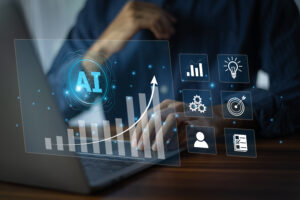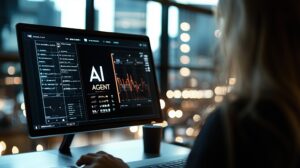What is AI ethics? Should there be an ethics of technology? Can AI make ethical decisions?
In this blog, we delve into the critical conversation surrounding the ethics of AI—examining issues such as transparency, accountability, and bias. As AI technology reshapes industries, there is an increasing need to ensure that innovation is paired with responsibility. From addressing the “black-box” nature of AI systems to mitigating the risks of bias and privacy concerns, this post explores the challenges and potential solutions for ethical AI integration.
Additionally, the blog discusses the impact of automation on employment, highlighting businesses’ responsibility to balance innovation with workforce development. By promoting transparency, accountability, and fairness, we can harness AI’s potential while safeguarding societal values.
Artificial intelligence seemingly revolutionizes all aspects of our lives, from how we shop to how businesses develop and work to solve problems. The growth of AI has been rapid. Over the last few years, AI has become a primary topic of conversation, especially as the industry has grown exponentially. According to data from Exploding Topics, the AI market was estimated to grow to $62.5 billion in 2022, and by 2025, it’s forecasted to reach $126 billion in annual revenue. This is incredible growth.
However, with this rapid growth across industries, challenges arise for data scientists to address, particularly with the ethics of AI. As AI continues evolving, so does the conversation around the ethical implications of its creation and use. These questions mostly revolve around fairness, transparency, accountability, and AI’s impacts on humans’ daily lives.
In this blog, we’ll explore the nuanced but critical conversation about the ethics of AI and the importance of finding a balance between fostering technological innovation and ensuring these tools are used responsibly.
Table of Contents:
The Challenge of Transparency & Accountability
Bias in AI: The Risk of Amplifying Inequalities
Privacy Concerns: Data Collection & Surveillance
Automation & the Impact on Employment
Mitigating the Impact of Automation
The Challenge of Transparency & Accountability
One of the biggest topics when discussing the ethics of AI is the challenge of transparency and accountability. AI algorithms, particularly those based on deep learning, are often described as “black-box” systems because while they produce outputs, the reasoning behind them or the process the machine takes to get there is often hidden or unclear, even from the developers.
Knowing this, how are humans supposed to trust systems when they don’t fully understand how they work? Moreover, who is responsible for the model when and if something goes wrong?
The Need for Transparency
With AI, transparency refers to the ability to understand and explain how the systems make decisions. No matter what AI is used for, whether in healthcare for medical diagnoses or HR to help make hiring decisions, transparency is essential to promote trust. That said, achieving transparency in AI isn’t as straightforward as it may seem.
Complex AI models, in particular, operate using large, extensive data sets, and explaining how exactly these systems work can be challenging for both experts and the average person.
In response to this dilemma, AI researchers have been working to create models that are easy to interpret and explain to the broader community. Still, achieving full AI transparency is a challenge, and researchers and developers will have to continuously monitor it to balance exploration in the tech community with ethical use cases.
AI Accountability
Similar to transparency, accountability is another chief concern regarding the ethics of AI. When an algorithm makes a mistake, who is responsible? Poor decisions made by AI can have far-reaching consequences, which makes answering this question of accountability even more difficult.
Say a model incorrectly diagnoses someone with an illness they don’t actually have, in turn missing the correct diagnosis, which delays the patient’s treatment. Who’s fault is that? Is it the AI? The developer? Someone else? Or, if a self-driving car causes an accident, who is to blame?
It’s a complex, nuanced question, and legal frameworks, like those established by the U.S. Government Accountability Office, are still developing as AI continues to grow. However, there is still work to be done in that department because AI technology is rapidly changing. Its use cases are expanding, so it’s still challenging to determine precisely who is responsible when AI systems fail or malfunction. One idea is that responsibility is evenly shared between developers, individual users, and the companies leveraging the AI systems. However, there isn’t a hard and fast rule governing all AI use.
Bias in AI: The Risk of Amplifying Inequalities
Unfortunately, the technology powering AI systems can be biased, just like humans. AI learns from data, and if the data the system is trained on contains biases, those biases will be reflected in the system’s outputs. In terms of the ethics of AI, bias can pose a serious risk, and without careful oversight, the AI algorithms can reinforce and even amplify existing biases. You can see these biases across industries, from healthcare to criminal justice, and even in hiring decisions.
Biased AI can have severe consequences for businesses that use it and the credibility of the AI industry as a whole. Think of industries where fairness is critical, like healthcare. Biased AI could lead to misdiagnoses and even unequal access to treatment, particularly for underrepresented groups of people. In the criminal justice sector, institutions using biased AI could perpetuate existing racial stereotypes or push unfair sentencing. These real-world consequences can emerge because of biased training data fueling AI algorithms.
To safeguard the ethics of AI, developers must prioritize fairness and inclusivity from the very beginning of the model’s creation. That means ensuring the training data is high-quality and unbiased.
Privacy Concerns: Data Collection & Surveillance
In any modern conversation about data, technology, and even the ethics of AI, privacy is a chief concern. With time, we’ve all become more and more selective about who we trust with our information—and that’s a good thing.
That said, AI algorithms thrive on large sets of personal information gathered across various touchpoints over time. In order to function, AI needs to collect and analyze consumer data, which raises significant privacy concerns regarding how the data is collected and used. There are two primary areas of concern regarding privacy issues with AI:
- Balancing Innovation & Surveillance
- The Need for Robust Data Governance
1. Balancing Innovation & Surveillance
There’s a fine line between using data for good to power innovation and overstepping into surveillance. On the one hand, useful AI technologies like personalized advertising, recommendation systems, and even smart devices need personal data to function and deliver a high-quality experience. However, those same technologies are also being used to track consumer behaviors and interests, which often happens without their full knowledge or consent.
The question of where this boundary should lie is a big predicament in conversations about the ethics of AI. How much data should be collected, and what level of consent is necessary? Should data collection become something the public grows to be OK with as technology advances? These questions don’t come with easy answers. In truth, the answers will likely evolve over time, which is another reason why guiding legal frameworks that can be adapted as needed are so necessary.
2. The Need for Robust Data Governance
Another big concern about privacy and the ethics of AI is how organizations using this technology can ensure the data they’re collecting is secure. To address these privacy concerns, organizations need strict, robust data governance policies outlining how data is collected, used, and stored.
When gathering consent to collect and use customer data, that consent must be transparent, informed, and easily revocable. This ensures the individual maintains consistent control over their personal information. Beyond that, AI systems must also be designed with privacy in mind. This can include integrating features like data anonymization and secure storage processes that help minimize the risk of breaches, misuse, and unauthorized access.
Automation & the Impact on Employment
As AI becomes more prominent and widespread, perhaps the most talked about issue has become the impact of automation on employment. At this point, we’ve all likely heard or been a part of a conversation where someone says that AI is coming to take away human jobs, and this concern has become a focal point in the ethics of AI.
AI-powered automation can, will, and has already reshaped the workforce, offering businesses opportunities for unprecedented innovation and efficiency. However, because this adoption has been so rapid and widespread, human workers across industries are increasingly concerned that machines could replace their jobs. In fact, according to data from SEO.AI, 30% of workers worldwide are afraid that AI may replace their jobs within the next three years.
AI & Job Displacement
Goldman Sachs estimates that AI may replace 300 million jobs, representing about 9.1% of all jobs worldwide. Keep in mind that this isn’t an even distribution across all job sectors. Instead, these replacements will primarily be seen in industries and professions where generative AI tools like writing and software development are most common. We’re also seeing these replacements in sectors like manufacturing, retail, and logistics as these algorithms are emerging to streamline routine, repetitive tasks.
On the one hand, this shift is great for productivity and economic growth. Streamlining routine tasks frees up human workers’ time for more engaging tasks and projects, so long as there’s still a budget left to pay them to work a different job than the one they were initially assigned before the AI stepped in. On the other hand, this shift creates a moral responsibility for businesses to consider the ethics of AI and the larger impact of displacing workers.
It’s a complex ethical dilemma that we still haven’t found the right solution for. Balancing technological progress and innovation with human costs is a challenging thing to do. Despite the benefits of using AI in the workforce, automation that leads to large-scale job loss without providing alternative employment opportunities could exacerbate economic inequality and social unrest, leading to a greater disdain and mistrust of AI technology.
Mitigating the Impact of Automation
Considering the implications of potential job displacement, research from the World Economic Forum indicates AI could create about 97 million new jobs by 2025, possibly outpacing the number of jobs that are expected to be replaced. To reap the benefits of this potential job boom, workers will need to increase their skill sets and learn how AI works and how to interact with it, as most of these roles may involve providing support to the algorithm.
Whether there is a significant job increase or decrease, the conversation surrounding the ethics of AI requires developers and businesses to integrate the technology to devise ways to mitigate the impact of AI on employees.
This is another situation where striking a balance is critical. Companies need to identify ways to embrace AI-powered automation and the opportunities it presents while also investing in workforce development that supports human workers.
Businesses can do this by prioritizing upskilling and reskilling programs that ensure employees are equipped with updated, relevant skills they can use to thrive in an AI-driven, tech-focused economy. Additionally, businesses and regulating bodies can collaborate to create policies and procedures that protect workers and ensure they deliver a fair transition from the current work environment to a more automated future. Even if an organization is set to replace multiple jobs with AI technology, supporting the human workers who were with the company before the tech emerged is still important.
Conclusion
The ethics of AI are complex and layered, and the conversation and questions about how best to navigate and integrate this technology into daily life are very nuanced and evolving. By working hard to foster transparency, take accountability, address biases, protect consumer privacy, and ensure we’re minimizing the impact on employment as best we can, we can find effective ways to navigate the fine line between innovation and exploitation with AI.
Today’s world is highly tech-driven, and that technology—including AI—isn’t going anywhere. If anything, it’s only becoming more enmeshed in our daily lives, both personally and in the workplace. With that in mind, the future of AI depends on our ability to strike that balance between progress and ethical responsibility. Everyone—from the developers to the organizations relying on this tech—has a part to play in ensuring AI is created and used to benefit all of society.
AI is a very powerful tool, and how we choose to wield it will determine whether it serves society for good or causes more harm than good. Navigating the ethics of AI is not so much about choosing whether or not to leverage this technology and innovate, but rather, it’s about finding ways to blend innovation and ethics to create a future where technology is equitable and inclusive for everyone involved.









4 Responses
Your blog is a treasure trove of knowledge! I’m constantly amazed by the depth of your insights and the clarity of your writing. Keep up the phenomenal work!
There is clearly a lot to know about this. I suppose you made some nice points in features also.
Muchas gracias por la informacion. Feliz semana. Un cordial saludo!
Gracias por la informacion. Feliz semana. Gracias!!